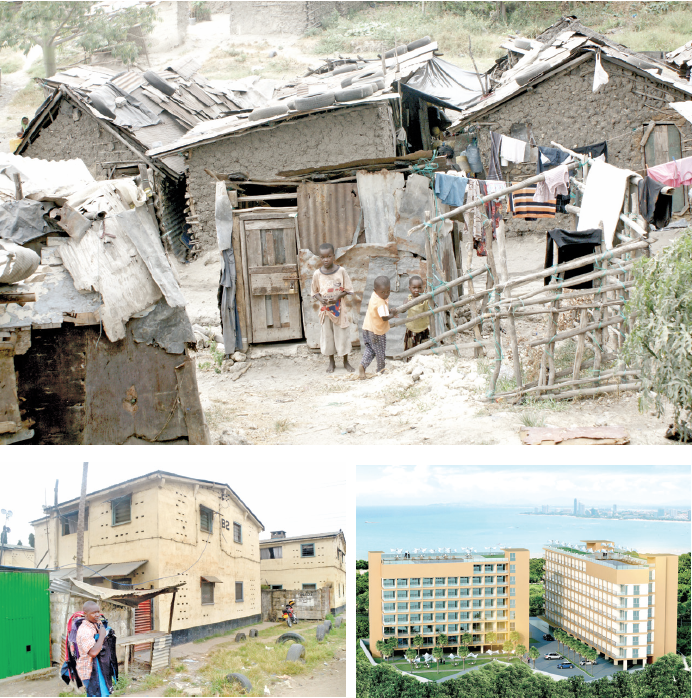The ugly, sordid side of Mombasa city

Hopes dwindle for Governor Joho’s elusive promise to replace old city estates with 20,000 modern highrise apartment blocks
Given the hype that characterised the colourful unveiling of an ambitious 20-year-Integrated Strategic Urban Development Plan dubbed Mombasa Vision (MV) 2035 early in 2016, it was clear Governor Hassan Joho’s administration was determined to turnaround the physical planning of the city.
The governor assured Mombasa residents that the plan would “transform the county into a vibrant world-class commercial hub by redeveloping the haphazardly organised city into a word class city”.
Graphics on display at the launch showed a complete departure from the current city clogged with informal settlements and old, dilapidated municipal houses. An artists’ impression depicted modern apartment blocks, which anybody would aspire to live in.
The launch came in the run up to 2017 General Election, handing Joho the desired political mileage necessary to ensure he clinched his second term in office.
The MV 2035 blue print envisioned a Sh200 billion housing component via which the county intended to convert Mombasa residents from perpetual tenants to homeowners. Old estates such as Khadija, Miritini, Buxton, Changamwe, Tudor, Nyerere, Mzizima, Kaa Chonjo, Likoni, and Tom Mboya were to be redeveloped and upgraded to provide “approximately 20,000 modern and affordable housing units for the residents.”
Contracts awarded
According to the immediate former Lands, Housing and Physical Planning executive Edward Nyale, the official ground-breaking for the housing project component was due in 2018.
Nyale had promised that by the end of 2019, residents would begin purchasing the units. He said three companies were scheduled to undertake the projects in the three estates separately.
Jabavu Village Limited was awarded Mzizima, Technofin got Changamwe while Goldline won the Likoni estate tender.
However, 2019 is over and there is nothing to show on the ground for Joho’s dream project. In October 2018, there was hope the project was finally taking off after the county ‘started issuing’ vacation notices to tenants in some of the old estates.
“They were here a year ago and the news going round that we would be evicted…but suddenly everything went quiet. Sometimes we wonder whether this project is just another scam…news has been coming and going just like Dengue fever and Chikungunya,” quipped Jacinta Mueni, a resident of Changamwe.
Several tenants residing in the dilapidated homes earmarked for re-development had resisted to move on grounds that the county had short-changed them. In Changamwe, Joho’s men had proposed to pay them Sh500,000 per household to vacate before scaling down the figure to Sh40,000 without explanation.
“We signed an agreement with the county government that guaranteed us Sh500,000 but they later changed tune, promising to pay us Sh40,000. Where can such peanuts take you under these harsh economic times? posed Vincent Otieno, a Changamwe tenant.
Confusion marred the relocation plan as some tenants claimed they had been issued with notices to vacate while others insisted they were yet to see any written notices.
This is in spite of county authorities announcing that they started re-locating more than 800 tenants from Mzizima, Likoni, Customs and Changamwe estates ahead of a planned ground breaking ceremony.
A local church was among those who have got notices to vacate.
“Moving from here will affect our funding sources and Christians will be affected spiritually,” reckoned Pastor George Were in an interview.
Some tenants started vacating the estates in fear of forceful evictions that never happened.
Despite promises by the county government that current tenants were to be given first priority to own the modern houses in the project, majority of tenants fear they could never return.
“It is impossible to expect tenants of our calibre who are used to paying rent for a single room at Sh600 per month to afford an apartment block…especially in a situation where there is a pay-out to vacate,” said Otieno.
Homes repainted
It is against the above backdrop that some of the residents have vowed to stay put. At Buxton estate where the county also faced resistance from a section of residents, the only notable changes were repainting of a few blocks. “They only renovated a few blocks and repainted them in blue and white,” said Mohamed Anwar, a resident of Buxton.
Four years after Joho launched the project, the residents’ hopes of sheltering in modern apartments are but a dream. However, officials at the Lands and Housing department insist plans are still intact and that ground breaking for the project is set for early this year.
County Lands, Housing and Physical planning Chief Officer Dr June Mwajuma says the county intends to begin the groundbreaking in Likoni flats in February 2020 for phase one of the project. “We are targeting to put up units to accommodate 10,000 residents in Likoni. From there we will move to Mzizima, then Changamwe and Buxton estates,” she said.
She was speaking on the sidelines of a stakeholders meeting convened at the Kenya School of Government (KSG) to discuss regulations for Mombasa County housing policy.
She said plans were underway to relocate 1,500 tenants ahead of the ground breaking of Phase One in Likoni with a view to accommodating them back “either as tenants or as house owners.”
Mombasa is a unique as it is a city island with a high population density compared to its landmass. “We have 1.3 million residents, but our day population increases and even doubles. We have to accommodate these masses, which is why we need to roll out this affordable housing project,” said Mwajuma.
“The programme that is going on here today of developing regulations for housing policy will go a long way in guiding us to implement these housing projects,” added the Chief Officer.
She said plans are underway to build more than 10,000 new units. “One option is to allow residents to purchase some of the homes at affordable prices and not at the property market rates…some of them can also rent at reasonable rates. We believe that should change the landscape of settlement in Mombasa because any sober government understands that populations rise daily,” she said.
The director in charge of Lands administration, Bartholomew Mwanyungu, blames lack of regulations for the project’s delay. “We could not start building without putting regulations. Otherwise we could find ourselves in court after the starting the projects,” he said.
Mwanyungu said the county, the National Land Commission (NLC), Directorate of Criminal Investigation (DCI) and the national government was in the process of consolidating titles of land parcels from within the targeted estates which were irregularly acquired.
Kenya Lands Alliance Member, Samshan Nagib wants the government to ensure there is enough land and good public participation before the redevelopment of the old estates.









